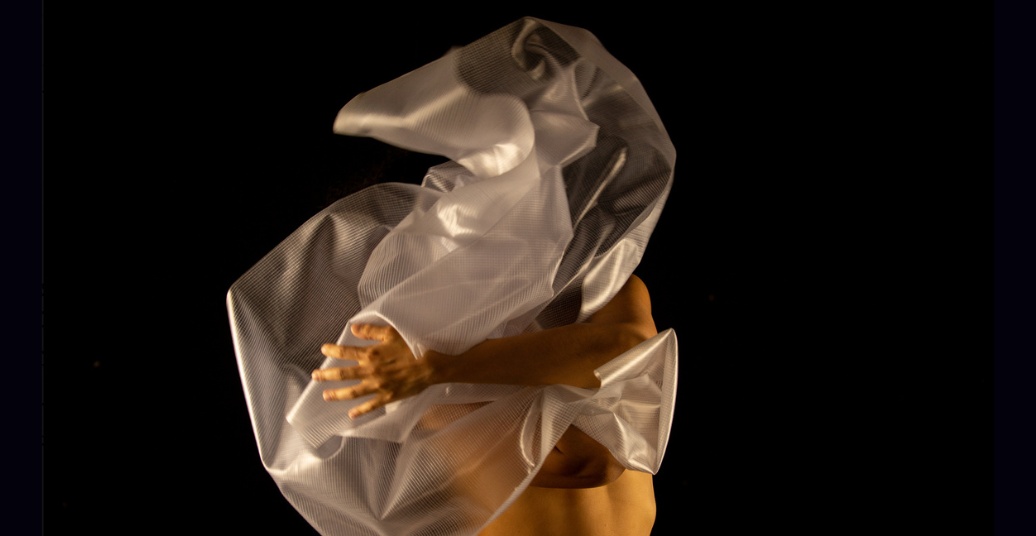The Most Beautiful Name of Fear, by Sofia Ó, was performed at Acker Stadt Palast on 12 and 13 April 2024. A gutsy solo, it hinges primarily on the charm of its performer.
Sofia Ó lies in a spotlight, on her side, facing away from us. Three long, narrow sheets of plastic hang from the ceiling, like unfurled banners. As the audience quietens down, Ó slowly begins to twitch, waves of motion spreading from her core to her extremities. Her white, translucent hooded top rustles with each movement. It looks like a stop motion film of a larva going through the stage of pupation. Her pelvis lifts from the floor, and we see that she is clutching a small, old-fashioned suitcase. As she opens it, another surprise: it is a self-contained record player. She pulls out a record, and sets it to play.
To the nostalgic crackle of a folk melody, Ó starts to turn in circles, echoing the movement of the spinning disc, at first on the floor then rising to her feet. If you look at her rotating form for long enough, like an optical illusion it almost appears as though she changes direction. Using rigorous technique to maintain the smoothness of the turns, Ó renders them mesmerising, but the presence of the small record player at the front of the stage has a shrinking effect. As performer and record revolve in tandem, Ó’s movement seems reduced to a mirror exercise, preventing me from seeing more than a literal act of replication.
The record player is put to one side and Ó reclaims the space, executing a series of quick, swiping motions, leaping and slicing the air with a sudden joyful quality. Her commitment to each movement, and seemingly bottomless reserves of energy, are highly convincing. Videos of Ó’s naked torso are projected onto the back wall, and the texture provided by the hanging sheets turns the stage into an underwater forest, with limbs becoming fronds of shifting seaweed. Ó sits in the corner and watches with us, as on screen her hands grab at her flesh, hiding and revealing parts of her body in turn. Interestingly, despite being pre-recorded, it is in the close-up shots that I see Ó relinquishing some of her control and composure.
There is a short interlude in the piece where Ó stands behind one of the plastic sheets and presses herself against it, her outline briefly turning it into a shower curtain. Later, the record player becomes a burden to be dragged around in circles, then lifted to the skies as though it is an offering, then shouldered as a casket. The piece also ends with Ó tearing down another of the plastic sheets, wrapping it around her face and standing on her head, planting herself into a polythene flowerpot. Yet somehow, these scenographic elements never quite seem to match Ó’s charisma as a performer. Perhaps it is an assumption based on seeing a choreographer perform their own solo work but, watching Ó move with abandon, it strikes me as an intensely personal piece. In her detailed movement, it is possible to see a myriad of small ambiguous images, which spark associations reaching beyond the easily defined. Her foot sliding unexpectedly out from underneath her, a sharp curve in the spine as though she had been punched in the gut — in the absence of biographical details, I can imagine what they might mean to Ó personally. Instead of allowing this movement to set sail, the other elements appear to tether it to the shore. It makes complete sense, especially in a solo, to use objects outside of the body as framing devices. In this case, perhaps the frame is too small for the performer.
The Most Beautiful Name of Fear, by Sofia Ó, was performed at Acker Stadt Palast on 12 and 13 April 2024.




